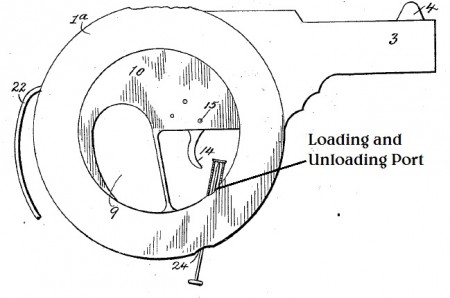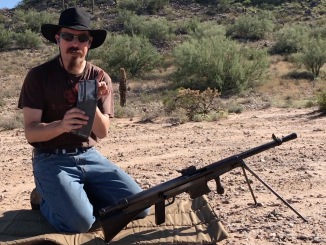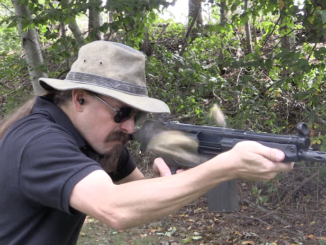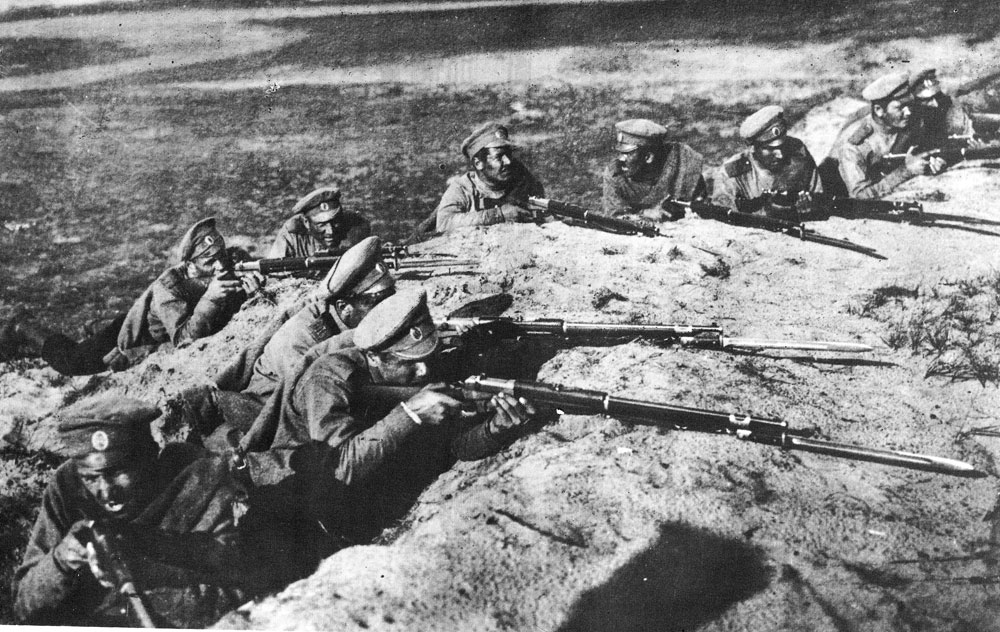Okay, to be precise I should say that it is W.B. McCarty’s idea for a peculiar revolver. We know nothing about Mr. McCarty beyond the fact that in 1909 he was granted a patent for a revolver concept in which the cylinder was oriented in a direction perpendicular to a conventional design:

As you can see this is a bit similar to some of the turret revolvers of the early 1800s, with the cartridges pointing out radially around the whole circumference of the cylinder. What makes it quite distinct from the turret gun design is that it uses the ammunition cylinder as the structural framework of the gun, and that it uses modern metallic cartridges. The gun that is most closely resembles mechanically is the Chicago Firearms Co. “Protector”.
The body of the weapon was intended to be a cover or frame, inside which the cylinder would rotate on rollers. The center void of the cylinder would hold the trigger, with a barrel extending out one side and a buttress out the other side to form a vaguely pistol-like grip for the device. As with the Protector palm pistol, McCarty’s gun would fire in a double-action manner, with the trigger first rotating a chamber into alignment with the barrel and then releasing the hammer to fire it. The gun was clearly designed for a very light cartridge, as the only breech lock in the gun is the intertia of the falling hammer itself, rather like a Flobert type breech.
The firing method is a bit unusual, and actually similar to the Ball Repeating Carbine which we looked at earlier this week. A portion of the rim of each (rimfire) cartridge is left exposed on the inside of the cylinder, and the short firing pin hits this protruding area with each shot. Total capacity of the piece is 18 rounds, at least according to the patent drawing (those sorts of details have a tendency to change when the first functional prototypes are actually built). Loading and unloading is done one round at a time through a port located at the bottom of the trigger cavity.

There is no evidence that McCarty was ever able to have any of his revolver manufactured…but wouldn’t it make a neat project for a home shop in something like .22 Short?
Thanks to Thomas for sending me the patent! You can download it here to read the whole description and see the other diagrams for yourself:
US Patent 913,756 (W.B. McCarty, “Revolver”, March 2, 1909)




Awesome it may look, but it is impractical. Loading time would be several minutes.
I’ve also heard tales of early rim-fire cartridges going off when they were jostled in magazines (like in a Spencer carbine), resulting in someone losing his head. Is this danger just a myth? I don’t like the idea of having this revolver getting hit by any sharp object and then desintigrating my hand…
Andrew .. I would hate to try and determine how many men during the Civil War carried their “rim” cartridges in their pockets, not neat little ammo pouches, and the millions of young and not so young men have and still do carry a pocket full of .22’s while rabbit or squirrel hunting. Been known myself to kind a .22 in the bottom oh my jeans pocket. Rim’s take quite a bit of abuse to go off, but should be treated with the usual care.
But the modern chemistry is not exact equal to half of 19 century chemistry. Anyone know which chemicals compounds were used in 19 century rimfire cartridges?
Your right about the vast difference in chemical constitutes then and now. Consider how chemical were compounded and the mechanics involved (or NOT involved). As stated in many accounts written at the time … misfire was a common occurrence and a greater worry.. not pre detonation. Even the early cap’s used in cap-ball weapons were subject to insensitivity from poor or lack of any quality control during manufacture and the detrimental effects of weather.
At the time it was fulminate of mercury. I think it is still used in those ‘poppers’ (the little paper balls the size of a rasin that children throw on the ground). It is stable enough. I think the real danger stemmed from inconsistant manufacture of the copper cases (if there was any).
Potassium perchlorate was the priming composition of choice by the time of this patent. Fulminate of mercury caused ‘season cracking’ of brass cartridge cases, so its usage diminished as ammunition cartridge cases were switched from pure copper to CDA 260 cartridge brass in the second half of the 19th Century. Noncorrosive lead styphnate becomes the priming composition of choice after World War II.
This concept was used by two frensh manufatoros, who stol from whoo?
@Peter
Did the french manage to create a working gun from this concept? I think it’s an interesting piece of engineering and i would love to get to know more about how they made it work, sofar i’ve only found one similar piece, the chicago palm as Ian also mentions.
The design doesn’t look like it would work in its current form as half of the case head is left unsupported, it would need to have some sort of rising block to support the case head for it to be able to work. Not to mention the fact that there isn’t any visible way to rotate the cylinder manually for reloading other than pulling the trigger.
When firing, case recoils and cocks supporting hammer,
and then, compressed mainspring expells the same into
foremost place in the chamber. Action repeats with
each trigger pull until all the rounds go off. Empty
magazine is rotated by fingernail or by extracting
rod through the ports cut to load or eject. However,
appearently, inventor was not aware, especially of
how empty cases retain their places in the magazine
after each shot since the absence of a statement of
that kind in the patent text.
Patent date: 1909
It’s attempt to build firearm as slim as semi-auto pistol but which itself is not pistol. Usage of available (revolver) rounds is also advantage
Sorry for the tangent, but a revolver is a pistol. It’s full title is ‘revolving cylinder repeating pistol’. That was too cumbersome, so it was shortened to just ‘revolver’. I have no clue as to how people got the idea that revolvers are not pistols.
Sorry. It should be “which itself is not automatic pistol” to be exact.
Probably because, in more recent times, the general public has come to associate the term “pistol” with semi-automatic / automatic pistols such as the Colt M1911, Walther PPK or Luger P08 as opposed to the readily-distinguishable revolver. Yet another case of an evolution in semantics stemming from the popular imagination.
By the way, I thought you made a very good point with your comment.
Actually, at least one of these peculiar beasts was built.
In Firearms Curiosa by Lewis Winant (1955), chapter 10 is titled “Turret and Chain Guns”. And on p.203 (NRA reprint ed.), photo 231 is of an “18-shot revolver/W.R. Funderberg collection”. It’s this beast, or an incredible coincidence.
Winant describes it as an “unmarked, probably European” pistol, and goes on to say;
If Winant noted the “Flobert-type” breech, that may have been what caused him to conclude it was “European” in origin.
The fact that he mentions the 18-shot magazine apparently needing to be removed for reloading may indicate a change in the design from the original patent with the loading port. The photo hows no evidence of such a port. Loading may have been accomplished along the lines of the drum on a Thompson or PPSh-41 SMG.
The existence of this one example might indicate that it is in fact the patent model itself.
OR….
It was in fact a European gadget, which McCarty attempted to patent here. We can extend him the benefit of the doubt and assume he had a legal right to do so, i.e., it may in fact be a design he attempted to patent in Europe first. (Although AFAIK, a pre-existing European patent would have been valid here as legal protection- is there a patent attorney in the house?)
Winant classes this critter with the “turret revolvers”, and I think that’s probably the best definition.
cheers
eon
Boring the holes in the disc from outside the disc would be easy enough, but to make a proper chamber for a rim-fire, or any cartridge, would be tricky as that operation would have to be done from the inside of the disc (to recess the rim, etc.) That would pretty much be a hand operation, or a machine operation only if an arbor were inserted all the way through and then tooling was attached to it, the chamber finished, then the tooling detached and the arbor removed. Either way, time consuming.
Not in the drawing, but one way to make the cylinders would be to make the turret as an empty “can” (like the percussion cap containers … on steroids …), bore a cylinder lengthwise in a square steel rod, place it in the can and align it with a couple of locating pins. Repeat until you have your 18 cylinders and close the can. Oh yeah. Drill the chamber mouths in the walls of the can when you make it.
Wouldnt it have been a better idea to let the wheel spin to the next bullet on it’s own using the explosion to reduce recoil rather than spinning the other way?